Tree-Ring-Recorded Drought Variability in the Northern Daxing’anling Mountains of Northeastern China
Abstract
:1. Introduction
2. Materials and Methods
2.1. Study Area and Tree-Ring Core Sampling
2.2. Tree-Ring Width Chronology Development
2.3. Climate Data
2.4. Statistical Analysis and Climate Reconstruction
3. Results
3.1. Climate-Growth Relationship
3.2. Reconstruction PDSIp6-7
(r = 0.620, N = 62, R2 = 0.386, R2adj = 0.375, F = 37.5, p < 0.0001),
3.3. Reconstructed PDSIp6-7 Variation
4. Discussion
4.1. Climate–Growth Relationship
4.2. Comparisons with Other Precipitation or Drought Reconstructions
4.3. Large-Scale Circulation Analysis
5. Conclusions
Author Contributions
Funding
Acknowledgments
Conflicts of Interest
References
- Dai, A.G. Drought under global warming: A review. Wiley Interdiscip. Rev. Clim. Chang. 2011, 2, 45–65. [Google Scholar] [CrossRef]
- Zhu, H.F.; Fang, X.Q.; Shao, X.M.; Yin, Z.Y. Tree ring-based February–April temperature reconstruction for Changbai Mountain in Northeast China and its implication for East Asian winter monsoon. Clim. Past 2009, 5, 661–666. [Google Scholar] [CrossRef] [Green Version]
- Chen, Z.J.; Zhang, X.L.; Cui, M.X.; He, X.Y.; Ding, W.H.; Peng, J.J. Tree-ring based precipitation reconstruction for the forest–steppe ecotone in northern Inner Mongolia, China and its linkages to the Pacific Ocean variability. Glob. Planet. Chang. 2012, 86–87, 45–56. [Google Scholar] [CrossRef]
- Liang, E.Y.; Liu, X.H.; Yuan, Y.J.; Qin, N.S.; Fang, X.Q.; Huang, L.; Zhu, H.F.; Wang, L.L.; Shao, X.M. The 1920s drought reconstructed by tree rings and historical documents in the semi-arid and arid areas of northern China. Clim. Chang. 2006, 79, 403–432. [Google Scholar] [CrossRef]
- Piao, S.L.; Ciais, P.; Huang, Y.; Shen, Z.H.; Peng, S.S.; Li, J.S.; Zhou, L.P.; Liu, H.Y.; Ma, Y.C.; Ding, Y.H.; et al. The impacts of climate change on water resources and agriculture in China. Nature 2010, 467, 43–51. [Google Scholar] [CrossRef] [PubMed]
- Yue, Y.; Shen, S.H.; Wang, Q. Trend and Variability in Droughts in Northeast China Based on the Reconnaissance Drought Index. Water 2018, 10, 318. [Google Scholar] [CrossRef]
- Bao, G.; Liu, Y.; Liu, N.; Linderholm, H.W. Drought variability in eastern Mongolian Plateau and its linkages to the large-scale climate forcing. Clim. Dyn. 2015, 44, 717–733. [Google Scholar] [CrossRef]
- Huang, J.G.; Zhang, Q.B. Tree rings and climate for the last 680 years in Wulan area of northeastern Qinghai-Tibetan Plateau. Clim. Chang. 2007, 80, 369–377. [Google Scholar] [CrossRef]
- Liang, E.Y.; Shao, X.M.; Xu, Y. Tree-ring evidence of recent abnormal warming on the southeast Tibetan Plateau. Theor. Appl. Climatol. 2009, 98, 9–18. [Google Scholar] [CrossRef] [Green Version]
- Shao, X.M.; Xu, Y.; Yin, Z.Y.; Liang, E.Y.; Zhu, H.F.; Wang, S.Z. Climatic implications of a 3585-year tree-ring width chronology from the northeastern Qinghai-Tibetan Plateau. Quatern. Sci. Rev. 2010, 29, 2111–2122. [Google Scholar] [CrossRef]
- Davi, N.K.; D’Arrigo, R.; Jacoby, G.C.; Cook, E.R.; Anchukaitis, K.J.; Nachin, B.; Rao, M.P.; Leland, C. A long-term context (931–2005 C.E.) for rapid warming over Central Asia. Quatern. Sci. Rev. 2015, 121, 89–97. [Google Scholar] [CrossRef] [Green Version]
- Yu, J.; Zhou, G.; Liu, Q.J. Tree-ring based summer temperature regime reconstruction in XiaoXing Anling Mountains, northeastern China since 1772 CE. Palaeogeogr. Palaeoclimatol. Palaeoecol. 2018, 495, 13–23. [Google Scholar] [CrossRef]
- Zheng, Y.H.; Zhang, Y.; Shao, X.M.; Yin, Z.Y.; Zhang, J. Temperature variability inferred from tree-ring widths in the Dabie Mountains of subtropical central China. Trees 2012, 26, 1887–1894. [Google Scholar] [CrossRef]
- Cai, Q.F.; Liu, Y. Climatic response of Chinese pine and PDSI variability in the middle Taihang Mountains, north China since 1873. Trees 2013, 27, 419–427. [Google Scholar] [CrossRef]
- Liang, E.Y.; Shao, X.M.; Qin, N.S. Tree-ring based summer temperature reconstruction for the source region of the Yangtze River on the Tibetan Plateau. Glob. Planet. Chang. 2008, 61, 313–320. [Google Scholar] [CrossRef]
- Liang, H.X.; Lyu, L.X.; Wahab, M. A 382-year reconstruction of August mean minimum temperature from tree-ring maximum latewood density on the southeastern Tibetan Plateau, China. Dendrochronologia 2016, 37, 1–8. [Google Scholar] [CrossRef]
- Garfin, G.M.; Hughes, M.K.; Liu, Y.; Burns, J.M.; Touchan, R.; Leavitt, S.W.; An, Z.S. Exploratory Temperature and Precipitation Reconstructions from the Qinling Mountains, North-Central China. Tree-Ring Res. 2005, 61, 59–72. [Google Scholar] [CrossRef] [Green Version]
- Chen, F.; Yuan, Y.J.; Wei, W.S.; Yu, S.L.; Shang, H.M.; Zhang, T.W.; Zhang, R.B.; Wang, H.Q.; Qin, L. Tree-ring based temperature reconstruction for the west Qinling Mountains (China): Linkages to the High Asia, solar activity and Pacific-Atlantic Ocean. Geochronometria 2014, 41, 234–244. [Google Scholar] [CrossRef]
- Zhang, R.B.; Yuan, Y.J.; Gou, X.H.; He, Q.; Shang, H.M.; Zhang, T.W.; Chen, F.; Ermenbaev, B.; Yu, S.L.; Qin, L.; et al. Tree-ring-based moisture variability in western Tianshan Mountains since A.D. 1882 and its possible driving mechanism. Agric. For. Meteorol. 2016, 218–219, 267–276. [Google Scholar] [CrossRef]
- Jiang, P.; Liu, H.Y.; Wu, X.C.; Wang, H.Y. Tree-ring-based SPEI reconstruction in central Tianshan Mountains of China since A.D. 1820 and links to westerly circulation. Int. J. Climatol. 2017, 37, 2863–2872. [Google Scholar] [CrossRef]
- Chen, F.; Yuan, Y.J.; Wei, W.S.; Yu, S.L.; Wang, H.Q. Tree-ring response of subtropical tree species in southeast China on regional climate and sea-surface temperature variations. Trees 2013, 29, 17–24. [Google Scholar] [CrossRef]
- Shi, J.F.; Lu, H.Y.; Li, J.B.; Shi, S.Y.; Wu, S.Y.; Hou, X.Y.; Li, L.L. Tree-ring based February–April precipitation reconstruction for the lower reaches of the Yangtze River, southeastern China. Glob. Planet. Chang. 2015, 131, 82–88. [Google Scholar] [CrossRef] [Green Version]
- Liu, Y.; Bao, G.; Song, H.M.; Cai, Q.F.; Sun, J.Y. Precipitation reconstruction from Hailar pine (Pinus sylvestris var. mongolica) tree rings in the Hailar region, Inner Mongolia, China back to 1865 AD. Palaeogeogr. Palaeoclimatol. Palaeoecol. 2009, 282, 81–87. [Google Scholar]
- Zhang, T.W.; Yuan, Y.J.; Wei, W.S.; Yu, S.L.; Zhang, R.B.; Shang, H.M.; Chen, F.; Fan, Z.A.; Qin, L. Tree-ring-based temperature reconstruction for the northern Greater Higgnan Mountains, China, since A.D. 1717. Int. J. Climatol. 2013, 33, 422–429. [Google Scholar] [CrossRef]
- Zhang, T.W.; Yuan, Y.J.; Wei, W.S.; Yu, S.L.; Zhang, R.B.; Chen, F.; Shang, H.M.; Qin, L. A tree-ring based precipitation reconstruction for the Mohe region in the northern Greater Higgnan Mountains, China, since AD 1724. Quatern. Res. 2014, 82, 14–21. [Google Scholar] [CrossRef]
- Zhang, X.L.; He, X.Y.; Li, J.B.; Davi, N.; Chen, Z.J.; Cui, M.X.; Chen, W.; Li, N. Temperature reconstruction (1750–2008) from Dahurian larch tree-rings in an area subject to permafrost in Inner Mongolia, Northeast China. Clim. Res. 2011, 47, 151–159. [Google Scholar] [CrossRef]
- Chen, Z.J.; Zhang, X.L.; He, X.Y.; Davi, N.K.; Cui, M.X.; Peng, J.J. Extension of summer (June–August) temperature records for northern Inner Mongolia (1715–2008), China using tree rings. Quatern. Int. 2013, 283, 21–29. [Google Scholar] [CrossRef]
- Shi, Z.J.; Xu, L.H.; Dong, L.S.; Gao, J.X.; Yang, X.H.; Lv, S.H.; Feng, C.Y.; Shang, J.X.; Song, A.Y.; Guo, H.; et al. Growth–climate response and drought reconstruction from tree-ring of Mongolian pine in Hulunbuir, Northeast China. J. Plant Ecol. 2015, 9, 51–60. [Google Scholar] [CrossRef] [Green Version]
- Stokes, M.A.; Smiley, T.L. An Introduction to Tree-Ring Dating; University of Arizona Press: Tucson, AZ, USA, 1968. [Google Scholar]
- Holmes, R.L. Computer-assisted quality control in tree-ring dating and measurement. Tree-Ring Bull. 1983, 43, 69–95. [Google Scholar]
- Cook, E.R.; Holmes, R.L. User’s Manual for Program ARSTAN; Laboratory of Tree-Ring Research, University of Arizona: Tucson, AZ, USA, 1986. [Google Scholar]
- Wigley, T.; Briffa, K.R.; Jones, P.D. On the average value of correlated time series, with applications in dendroclimatology and hydrometeorology. J. Clim. Appl. Meteorol. 1984, 23, 201–213. [Google Scholar] [CrossRef]
- Dai, A.G.; Trenberth, K.E.; Qian, T. A global dataset of palmer drought severity index for 1870–2002: Relationship with soil moisture and effects of surface warming. J. Hydrometeorol. 2004, 5, 1117–1130. [Google Scholar] [CrossRef]
- Braganza, K.; Gergis, J.L.; Power, S.B.; Risbey, J.S.; Fowler, A.M. A multiproxy index of the El Nino-Southern Oscillation, A.D. 1525–1982. J. Geophys. Res. Atmos. 2009, 114, D05106. [Google Scholar] [CrossRef]
- Trouet, V.; Esper, J.; Graham, N.E.; Baker, A.; Scourse, J.D.; Frank, D.C. Persistent positive North Atlantic oscillation mode dominated the medieval climate anomaly. Science 2009, 324, 78–80. [Google Scholar] [CrossRef] [PubMed]
- Michaelsen, J. Cross-validation in statistical climate forecast models. J. Clim. Appl. Meteorol. 1987, 26, 1589–1600. [Google Scholar] [CrossRef]
- Fritts, H.C. Tree Rings and Climate; Academic Press: London, UK, 1976. [Google Scholar]
- Chen, Z.J.; He, X.Y.; Davi, N.K.; Zhang, X.L. A 258-year reconstruction of precipitation for southern Northeast China and the northern Korean peninsula. Clim. Chang. 2016, 139, 609–622. [Google Scholar] [CrossRef]
- Cook, E.R.; Anchukaitis, K.J.; Buckley, B.M.; D’Arrigo, R.D.; Jacoby, G.C.; Wright, W.E. Asian monsoon failure and megadrought during the last millennium. Science 2010, 328, 486–489. [Google Scholar] [CrossRef] [PubMed]
- Mann, M.E.; Lees, J. Robust estimation of background noise and signal detection in climatic time series. Clim. Chang. 1996, 33, 409–445. [Google Scholar] [CrossRef]
- Torrence, C.; Compo, G.P. A practical guide to wavelet analysis. Bull. Am. Meteorol. Soc. 1998, 79, 61–78. [Google Scholar] [CrossRef]
- Sun, B.; Liu, Y.; Lei, Y.; Guo, L. Warm-induced aridification in eastern Inner Mongolia evidenced by tree rings. Dendrochronologia 2017, 42, 73–79. [Google Scholar] [CrossRef]
- Cai, Q.F.; Liu, Y.; Lei, Y.; Bao, G.; Sun, B. Reconstruction of the March–August PDSI since 1703 AD based on tree rings of Chinese pine (Pinus tabulaeformis Carr.) in the Lingkong Mountain, southeast Chinese loess Plateau. Clim. Past 2014, 10, 509–521. [Google Scholar] [CrossRef]
- Liang, E.Y.; Shao, X.M.; Liu, H.Y.; Eckstein, D. Tree-ring based PDSI reconstruction since AD 1842 in the Ortindag Sand Land, east Inner Mongolia. Chin. Sci. Bull. 2007, 52, 2715–2721. [Google Scholar] [CrossRef]
- Liu, Y.; Zhang, X.J.; Song, H.M.; Cai, Q.F.; Li, Q.; Zhao, B.Y.; Liu, H.; Mei, R.C. Tree-ring-width-based PDSI reconstruction for central Inner Mongolia, China over the past 333 years. Clim. Dyn. 2017, 48, 867–879. [Google Scholar] [CrossRef]
- Zhang, X.J.; Liu, Y.; Song, H.M.; Cai, Q.F.; Li, Q.; Zhao, B.Y.; Liu, H.; Mei, R.C. Interannual variability of PDSI from tree-ring widths for the past 278 years in Baotou, China. Trees 2017, 5, 1531–1541. [Google Scholar] [CrossRef]
- Zhang, X.L.; Cui, M.X.; Ma, Y.J.; Wu, T.; Chen, Z.J.; Ding, W.H. Larix gmelinii tree-ring width chronology and its responses to climate change in Kuduer, Great Xing’ an Mountains. J. Appl. Ecol. 2010, 21, 2501–2507, (In Chinese with English Abstract). [Google Scholar]
- Liu, N.; Liu, Y.; Bao, G.; Bao, M.; Wang, Y.C.; Ge, Y.X.; Zhang, L.Z.; Bao, W.; Tian, H. A tree-ring based reconstruction of summer relative humidity variability in eastern Mongolian Plateau and its associations with the Pacific and Indian Oceans. Palaeogeogr. Palaeoclimatol. Palaeoecol. 2015, 438, 113–123. [Google Scholar] [CrossRef]
- Li, Y.J.; Wang, S.Y.; Niu, J.J.; Fang, K.Y.; Chao, Y.; Li, X.L.; Li, Y.H. Tree-ring-based reconstruction of drought variability (1792–2011) in the middle reaches of the Fen River, North China. Dendrochronologia 2016, 40, 1–11. [Google Scholar] [CrossRef]
- Meehl, G.A. The annual cycle and interannual variability in the tropical Pacific and Indian Ocean regions. Mon. Weather Rev. 1987, 115, 27–50. [Google Scholar] [CrossRef]
- Labitzke, K.G.; van Loon, H. The Stratosphere: Phenomena, History and Relevance; Springer: Berlin, Germany, 1999. [Google Scholar]
- Sun, F.H.; Yuan, J.; Lu, S. The Change and Test of Climate in Northeast China over the Last 100 Years. Clim. Environ. Res. 2006, 11, 101–108, (In Chinese with English Abstract). [Google Scholar]


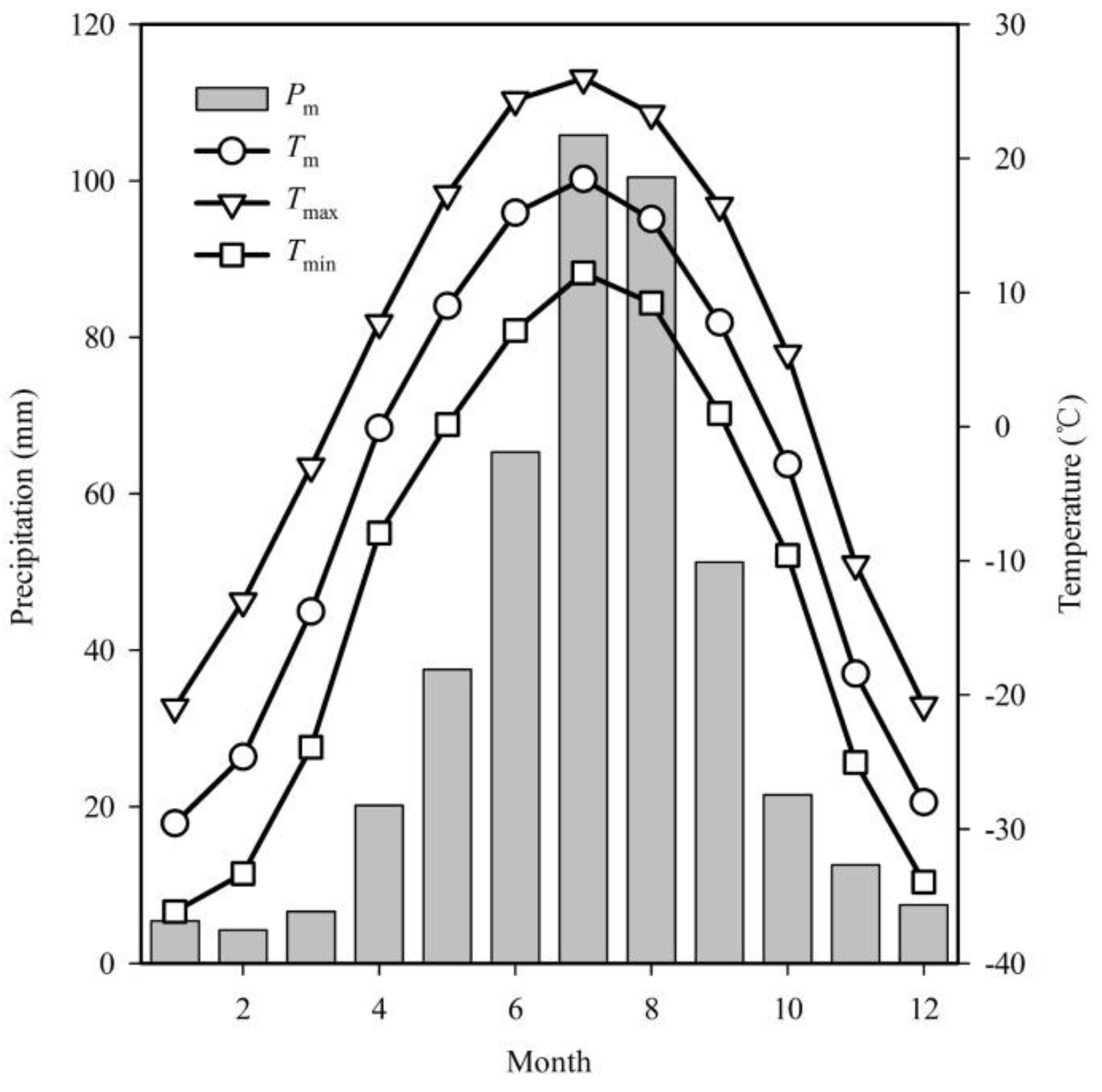
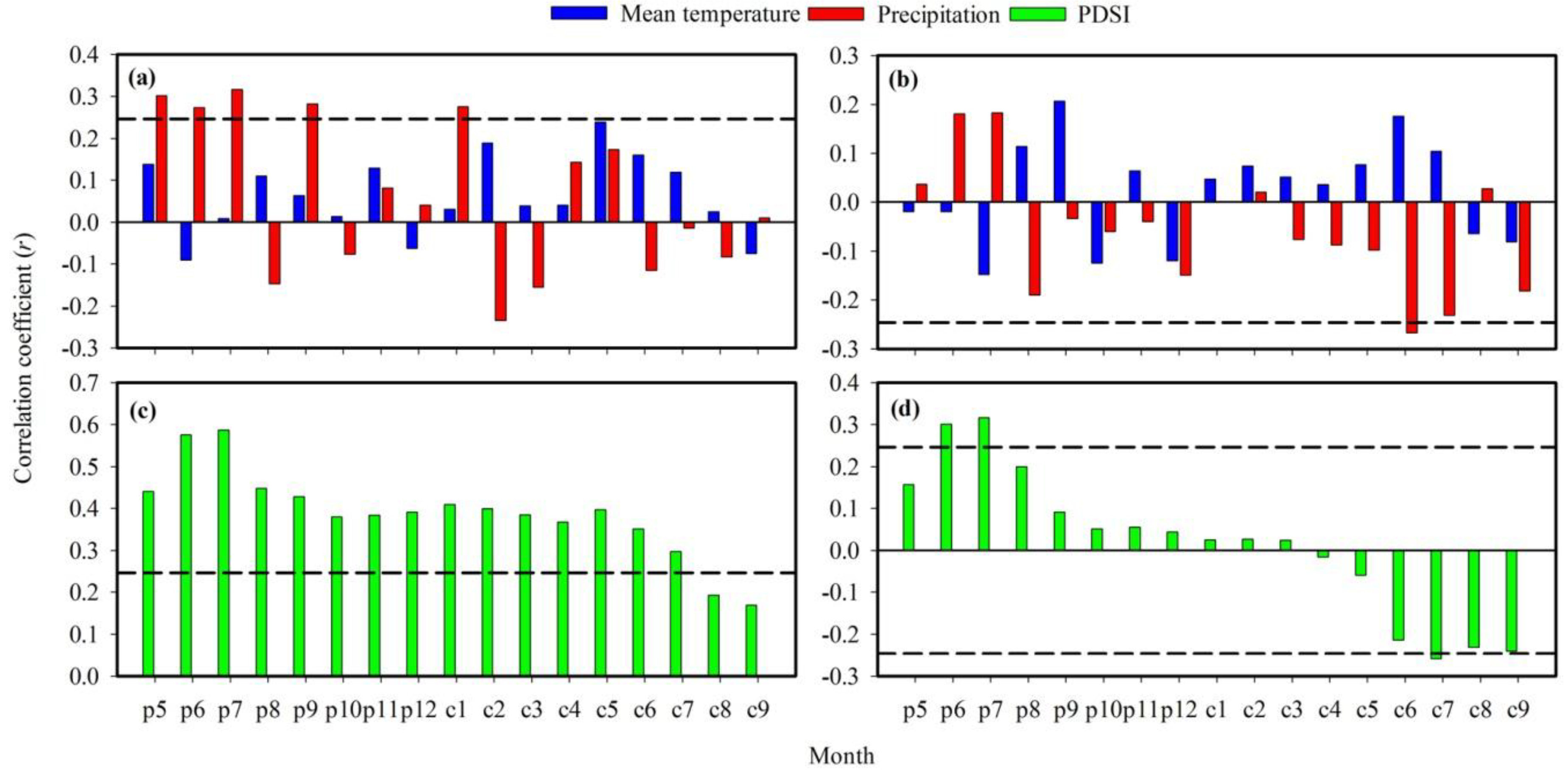
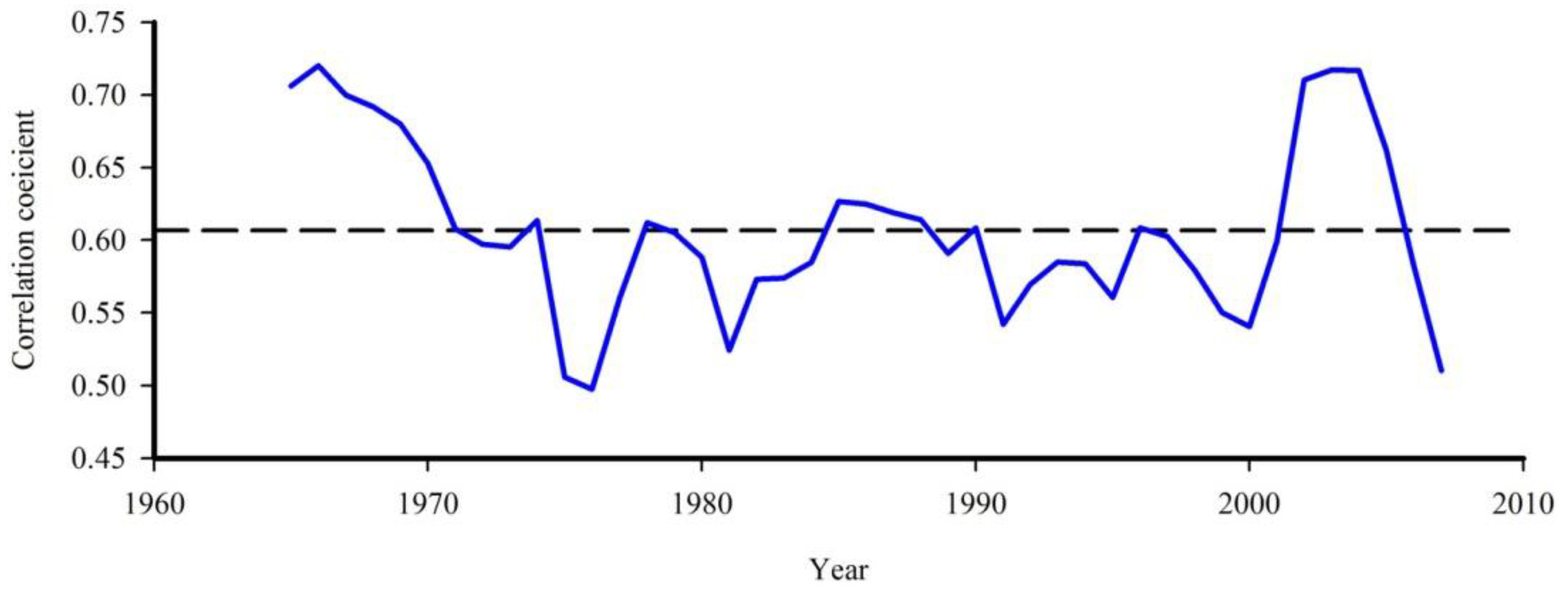
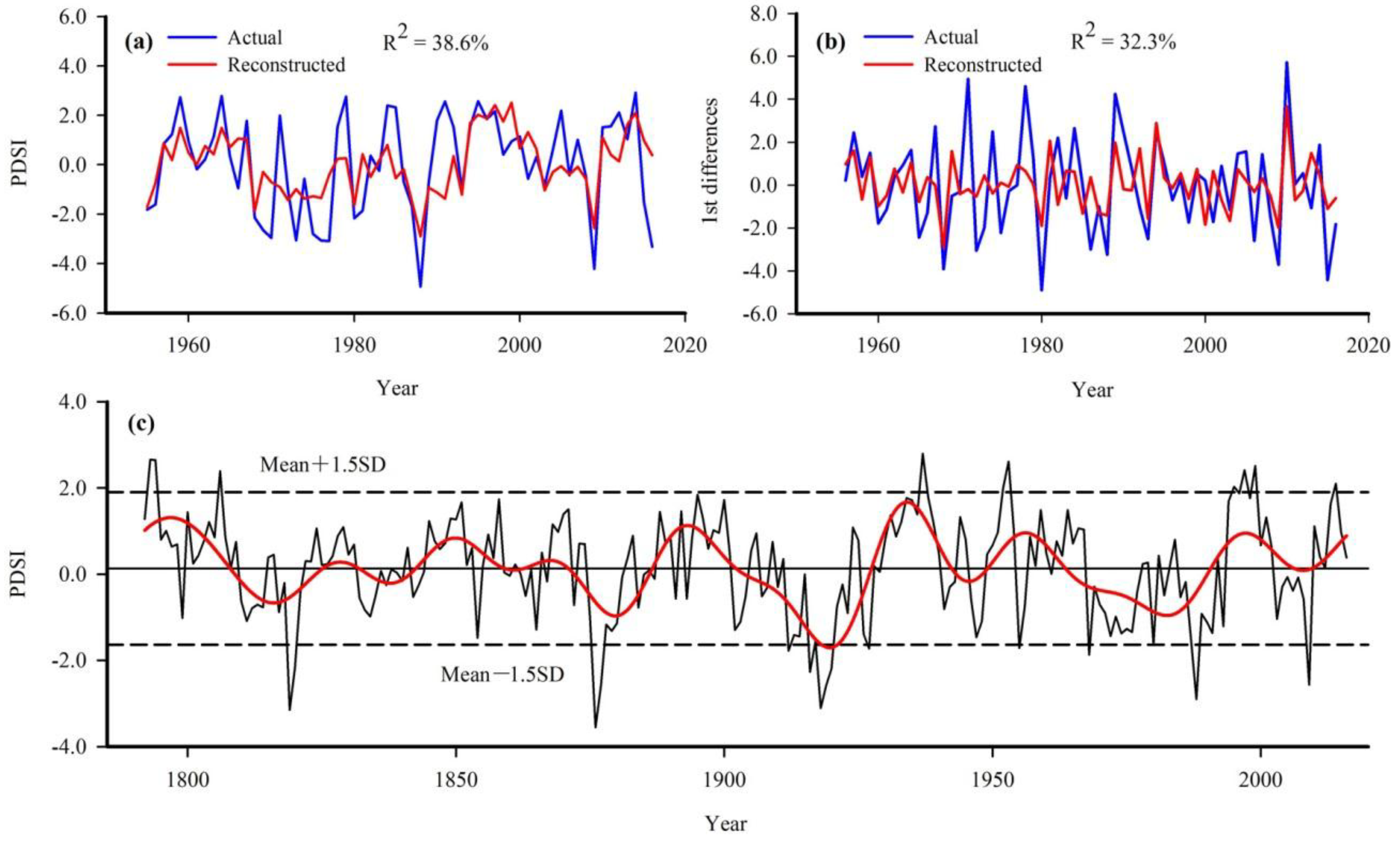


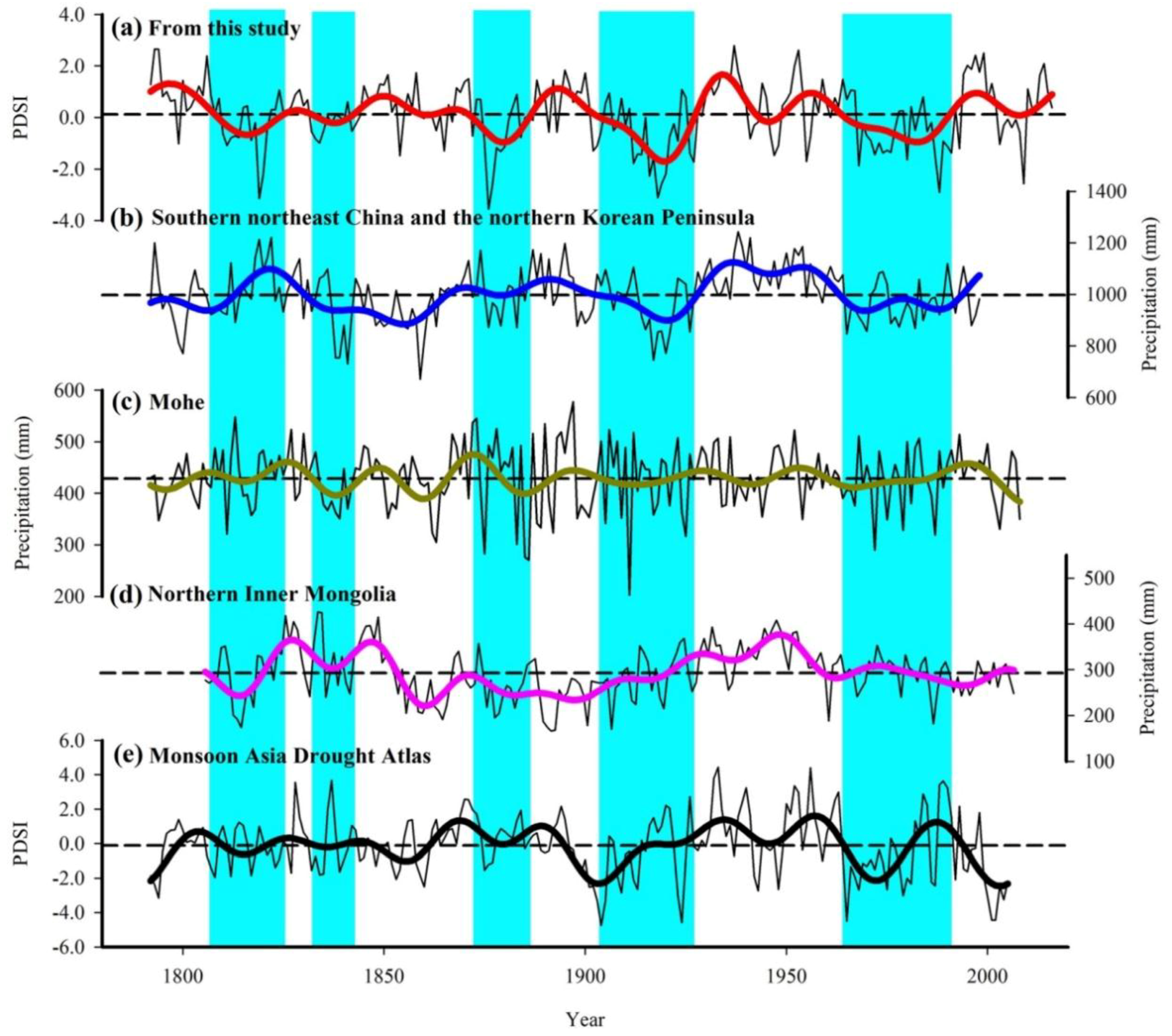

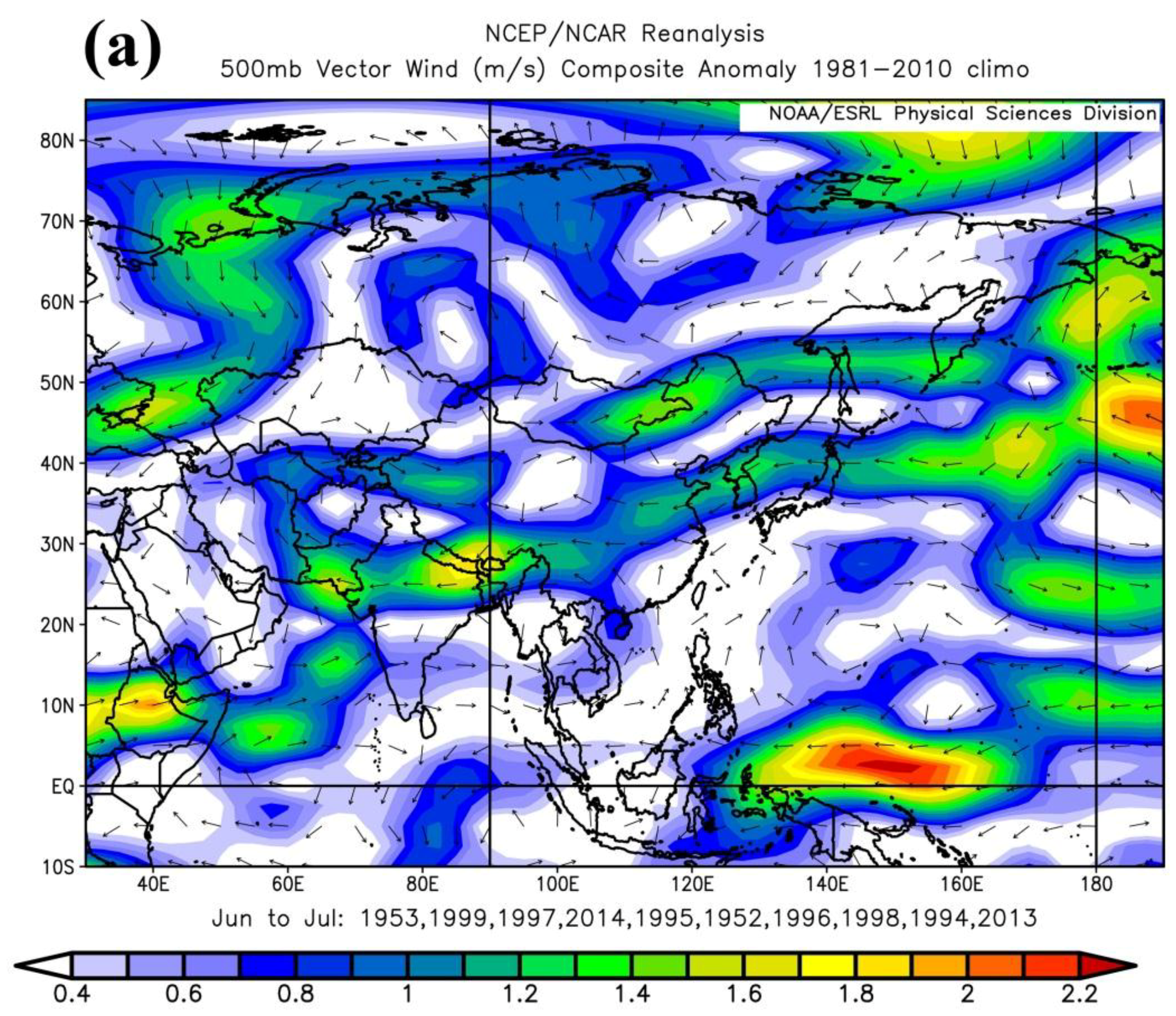
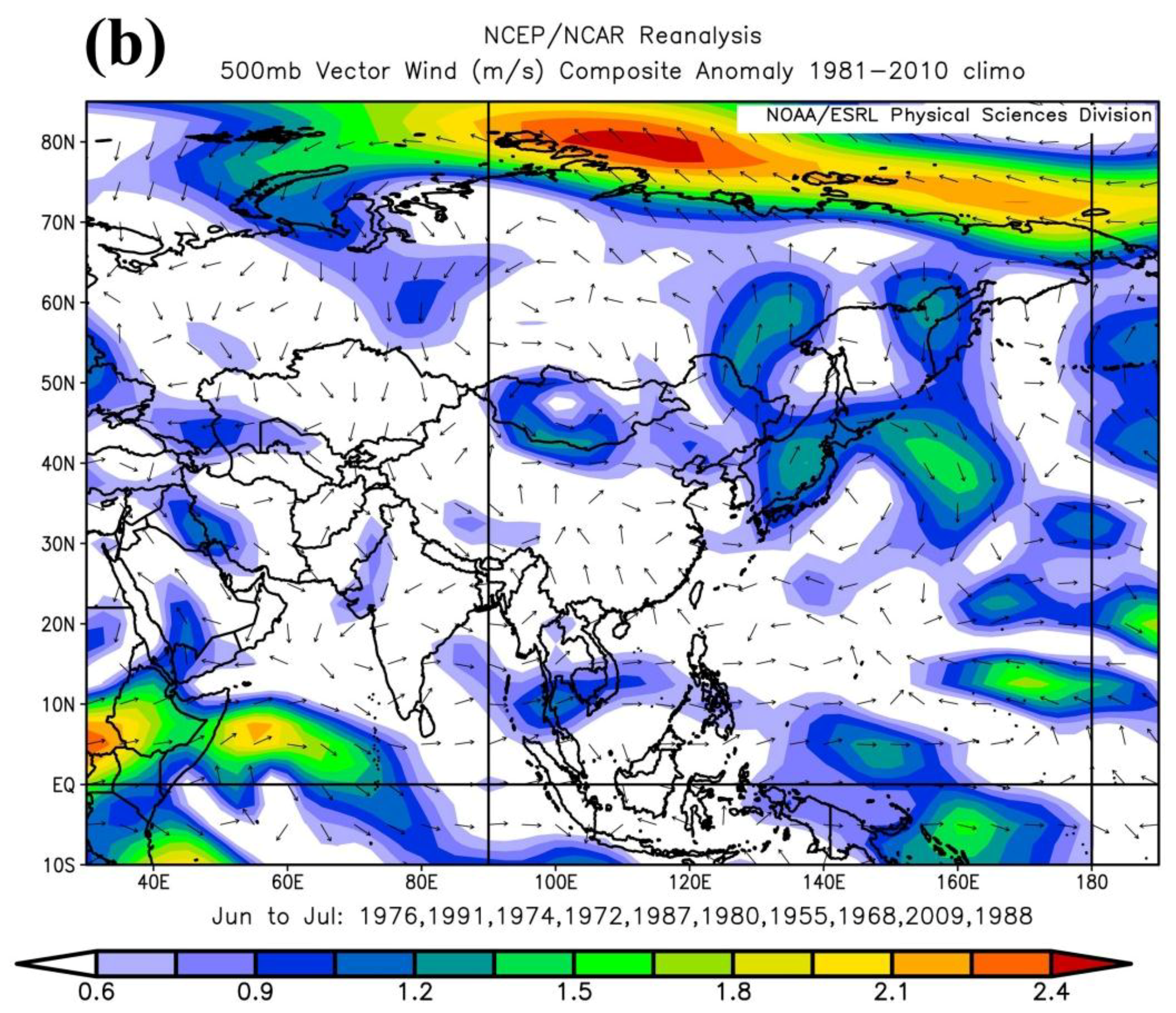
| Site Code | Species | Latitude (N) | Longitude (E) | Elevation (m) | Cores Number | Aspect | Slope |
|---|---|---|---|---|---|---|---|
| HXL | P. sylvestris | 52°12′21.18″ | 122°14′49.22″ | 739 | 34 | S | 30° |
| NSC | P. sylvestris | 52°02′40.47″ | 122°06′02.75″ | 789 | 32 | S | 25° |
| Period | R | R2 | R2adj | r | RE | ST | RMSE | PMT |
|---|---|---|---|---|---|---|---|---|
| 1955–2016 | 0.620 | 0.386 | 0.375 | 0.589 | 0.346 | 48/14 | 1.588 | 2.114 |
© 2018 by the authors. Licensee MDPI, Basel, Switzerland. This article is an open access article distributed under the terms and conditions of the Creative Commons Attribution (CC BY) license (http://creativecommons.org/licenses/by/4.0/).
Share and Cite
Yu, J.; Shah, S.; Zhou, G.; Xu, Z.; Liu, Q. Tree-Ring-Recorded Drought Variability in the Northern Daxing’anling Mountains of Northeastern China. Forests 2018, 9, 674. https://doi.org/10.3390/f9110674
Yu J, Shah S, Zhou G, Xu Z, Liu Q. Tree-Ring-Recorded Drought Variability in the Northern Daxing’anling Mountains of Northeastern China. Forests. 2018; 9(11):674. https://doi.org/10.3390/f9110674
Chicago/Turabian StyleYu, Jian, Sher Shah, Guang Zhou, Zhenzhao Xu, and Qijing Liu. 2018. "Tree-Ring-Recorded Drought Variability in the Northern Daxing’anling Mountains of Northeastern China" Forests 9, no. 11: 674. https://doi.org/10.3390/f9110674




